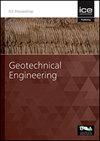Performance of a long irregular excavation by the top-down technique in a downtown area
IF 1.7
4区 工程技术
Q3 ENGINEERING, GEOLOGICAL
Proceedings of the Institution of Civil Engineers-Geotechnical Engineering
Pub Date : 2022-04-05
DOI:10.1680/jgeen.21.00156
引用次数: 1
Abstract
A 1257 m-long special-shaped deep excavation was performed in the city center of Nanjing, China. Full-width and half-width top-down construction methods were adopted. Based on the long-term monitoring data of the project, this paper analyzed the evolution characteristics of the diaphragm wall deformation, the ground settlement and the settlement of adjacent buildings and discussed their interrelationships and their relationships with the excavation process, structural system and geological conditions. The results showed that the horizontal displacement of the diaphragm walls was less than 1% of the excavation depth and that the position of the maximum horizontal displacement was generally located from 4 m above the excavation surface to the vicinity of the excavation surface. The influence range of excavation on the surrounding ground settlement was mostly within three times the excavation depth, and the ground settlement varied from 0.1%∼0.5% of the excavation depth to 0.3∼5 times the maximum horizontal displacement of the diaphragm wall. During the construction process, the settlement rate suddenly increased only when the excavation reached the soft soil layer. Building settlement was related to the excavation deformation, structure forms, foundation types and distance to the foundation pit.采用自顶向下技术在市区进行长不规则开挖
中国南京市中心进行了一次1257米长的异形深挖。采用全宽、半宽自上而下施工方法。根据工程长期监测资料,分析了地下连续墙变形、地面沉降和邻近建筑物沉降的演变特征,探讨了它们之间的相互关系以及与开挖过程、结构体系和地质条件的关系。结果表明:连续墙水平位移小于开挖深度的1%,最大水平位移位置一般位于开挖面以上4 m至开挖面附近。基坑开挖对周边地表沉降的影响范围多在3倍开挖深度内,地表沉降变化范围为开挖深度的0.1% ~ 0.5%至连续墙最大水平位移的0.3 ~ 5倍。在施工过程中,只有开挖到软土层时沉降速率才突然增大。建筑物沉降与开挖变形、结构形式、地基类型及与基坑的距离有关。
本文章由计算机程序翻译,如有差异,请以英文原文为准。
求助全文
约1分钟内获得全文
求助全文
来源期刊
CiteScore
4.40
自引率
4.50%
发文量
68
审稿时长
3 months
期刊介绍:
Geotechnical Engineering provides a forum for the publication of high quality, topical and relevant technical papers covering all aspects of geotechnical research, design, construction and performance. The journal aims to be of interest to those civil, structural or geotechnical engineering practitioners wishing to develop a greater understanding of the influence of geotechnics on the built environment.

 求助内容:
求助内容: 应助结果提醒方式:
应助结果提醒方式:


